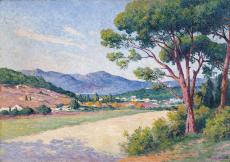


Born to a family of workers, Maximilien Luce was encouraged by his parents to practise drawing for the immediate purpose of acquiring a trade. He apprenticed as a carver of woodcuts for illustrations, for which qualified craftsmen were still in high demand, but he wanted to paint. His teacher at the time, Carolus-Duran (1837-1917), recognised the nascent talent in the figures and suburban views painted by his protegé around 1875, and encouraged him to pursue his chosen path. After his military service and as commercial woodcuts were beginning to be supplanted by other techniques, Luce decided to dedicate himself once and for all to painting.
The year 1887 marked a turning point for Luce: he exhibited at the Salon des Indépendants, where he was welcomed by Georges Seurat (1859-1891) and Paul Signac (1863-1935), who in turn presented him to Camille Pissarro (1830-1903). Henceforth, Luce became a loyal exhibitor at the Indépendants and one of the principal representatives of the Neo- Impressionist movement. In this capacity, he was often invited, until 1900, to the Salon of the Belgian avant-garde Les XX group and later of the Libre Esthétique artistic society. Luce’s painting is certainly Divisionist, due to the use of pure and contrasting colours, although the artist used lax brushstrokes which slightly obey the laws on the dynamics of lines formulated by the mathematician Charles Henry and advocated by the Neo-Impressionists. Meanwhile, his loyalty to his working-class origins and his political, socialist and anarchist convictions were reflected in his choice of subject matter: the description of the daily life of the common people; the Parisian industrial suburbs; and Charleroi and the Borinage region in Belgium, where, in 1896, he painted the steelworks and the factories. His political commitment, which he shared with Seurat, Signac and their mutual friend, the art critic Félix Fénéon, led him to collaborate with anarchist journals, and his activism landed him in prison, in 1894, following the notorious ‘Trial of the Thirty’. Soon released from prison, he was able to return to painting and to making known the misery of the proletariat, while exalting the nobility of the worker. One of his acclaimed political works, Une Rue à Paris en Mai 1871 (Paris, Musée d’Orsay), was presented at the Salon des Indépendants of 1905, when the memory of the horrors of the Paris Commune were still a burning issue amongst his contemporaries.
Luce’s dark, militant streak was thoroughly counterbalanced by the execution of luminous landscapes. For example, it was following a stay in London in 1892, during which time he painted the capital of industry, that he visited Saint-Tropez for the first time and painted a series of canvases. He returned to the region, to Saint-Clair, in 1903 and dated this landscape in the A. G. Leventis Collection, traditionally identified as Saint-Tropez, to 1904-1905, thus underscoring the lengthy inception of the work. This bright, colourful painting – in which the ‘broken’ brushstrokes, assimilated, make way for a more fluid execution – is very different from the contemporary works of Signac or Henri-Edmond Cross (1856-1910). It also reveals the artist’s concern for composition, the serene mastery of a beautiful craft.
Around this time, Luce’s career soared, with solo exhibitions at the Galerie Druet (1904, 1906) and the Galerie Bernheim-Jeune (1907), which helped to make him known outside France, and particularly in Germany, where a small group of admirers championed the cause – after the masters of the first generation of Impressionists – of Paul Gauguin (1848-1903), Vincent van Gogh (1853-1890), the Neo-Impressionists and the Nabis. This familiarity with the milieu of the Parisian avant-garde would prove to be of capital importance in the development of painting in Germany before 1914, especially in relation to the artists of the Blaue Reiter group. It is interesting to note that Saint- Tropez, Route du Pinet hung on the walls of the Munich apartment of the banker Alfred Wolff (1866-1959), probably around 1908, among furniture designed by the Belgian architect Henry Van de Velde (1863-1957). This connoisseur and friend of the famous Count Harry Kessler (1868-1937), of the critic Julius Meier-Graefe (1867-1935) and of other Francophile collectors living in Weimar also owned works by Signac, Cross, Maurice Denis (1870-1943), Pierre Bonnard (1867-1947), Aristide Maillol (1861-1944) and van Gogh, as well as the legendary Gauguin.
Born to a working-class family in Montparnasse, he began his career as a carver of woodcuts for illustrations and also trained with Carolus-Duran, who encouraged him to paint. Camille Pissarro, who shared his anarchist convictions, introduced him to Neo-Impressionism. Known mostly for his Pointillist canvases, he also produced numerous prints and posters. He depicted landscapes and contemporary urban scenes, which often portray workers, emphasising the play of light, both natural and artificial.